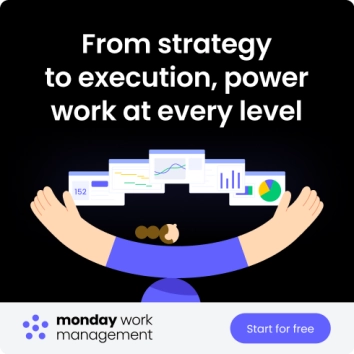In project management, the planning phase gets a lot of attention, but it’s in the execution phase where plans meet reality. This is where the strategy-to-execution gap often appears—the frustrating space between a brilliant plan and a successful outcome. Why does this happen?
Even the best strategies can falter without a clear execution process, leading to missed deadlines, budget overruns, and misaligned teams. According to the Project Management Institute, a significant portion of projects fail to deliver their full benefits, not because of poor planning, but because of breakdowns during execution.
This guide will walk you through everything you need to bridge that gap. We’ll cover key terms, a step-by-step process for flawless execution, and how a Work OS like monday.com provides the visibility and control needed to turn your plans into achievements.
TL;DR: What you need to know
Project execution is the phase where plans become reality. Success hinges on bridging the gap between strategy and action through clear processes, effective resource management, and a powerful Work OS to maintain visibility and control over every moving part.
What is project execution?
What is project execution?
Project execution—sometimes called project implementation—is the process of putting the activities outlined in your project plan into action. It’s the third and often longest phase in the project management life cycle, where the team does the work to create the final deliverables for stakeholders.
During this phase, teams build deliverables, project managers monitor progress against the plan, and stakeholders are kept informed. Key activities include managing resources, executing tasks, conducting status meetings, and updating project documentation. It’s a dynamic phase where project managers shift from planning to actively leading and coordinating the team’s efforts.
Why the project execution phase is critical for success
Why the project execution phase is critical for success
The execution phase is where a project’s value is truly delivered. Flawless execution directly impacts ROI, ensures strategic alignment, and provides the visibility needed for confident decision-making. For executives, this means seeing how individual projects contribute to larger business goals.
Effective execution prevents resource waste, keeps projects on budget, and builds trust with stakeholders by delivering on promises. Using tools like real-time dashboards gives leaders a high-level view of progress across an entire project portfolio, allowing them to spot risks and make strategic adjustments before they become critical issues.
The key components of a project execution plan (PEP)
The key components of a project execution plan (PEP)
A Project Execution Plan (PEP) is a formal document that details how the project plan will be carried out. It acts as the single source of truth for the project team and stakeholders, ensuring everyone is aligned on the ‘how’.
A comprehensive PEP typically includes:
- Scope and objectives: A clear definition of project boundaries and what success looks like.
- Deliverables and quality standards: What will be produced and the criteria for its acceptance.
- Schedule and milestones: The project timeline with key dates and deadlines.
- Resource allocation: Who is responsible for what, including team members, budget, and tools.
- Risk management plan: A register of potential risks and the strategies to mitigate them.
- Communication plan: How, when, and with whom project information will be shared.
To get you started, we’ve created a customizable template to help you build your own PEP.
8 steps to a flawless project execution process
8 steps to a flawless project execution process
Even though project execution is a step within a process, you can also break it down into several steps for success. Here’s a rundown of eight of them, and how monday.com Work OS can help you do it.
1. Choose and implement a project management software
This is the first step, because our other seven steps for successful project execution truly hinge on it. The right project management software provides true visibility into a project’s execution—all of the tasks, people, and metrics you need. A few classic project execution tasks you can entrust in monday.com to work the best way possible are:
- Time tracking
- File storage
- Scheduling
- Communication
- Integration with your favorite apps
In each of the following steps, we’ll mention a feature—or two—that makes it all possible.
2. Delegate tasks effectively
Project managers understand that when a task falls into a certain category, it needs to be assigned to a certain team member or members. On monday.com, you can do this more efficiently in two ways:
- People Column: Use this column to assign individuals or multiple people and teams to a project activity.
- Statuses and automations: For new tasks that fall under a specific category, say stakeholder communication, you can create an automation that whenever a new one is made with this status will automatically assign a specific person.
3. Provide resources that empower your team
Beyond a project manager, there are the dedicated team members on the ground of a project—all with different work styles and preferences. monday.com allows you to bring them all together, but still allow for customization that can make all the difference:
- 15+ board views: Team members can view boards exactly how they want, using Views like Gantt chart, Kanban, and more in addition to advanced filters and a search function.
- Custom statuses and columns
4. Build a risk management plan
Risk or crisis can rear their ugly heads during project execution. You can refer back to a Risk Register that you create on our platform, to reduce wasted time and negative impact of not knowing who and how certain risks should be handled.
5. Support effective communication
The right project management software makes it effortless to support and encourage centralized communication. On monday.com, you can use Updates on items for communication threads and announcements, comments, and even annotate assets. You can also easily sync on content via other apps and integrations.
6. Make progress check-ins routine
Routine progress checks are key to catching signs of trouble—or unexpected progress that could free up time or resources for other activities. With monday.com, you can automate reminders for upcoming meetings and even send dashboard reports out to internal and external stakeholders.
7. Manage scope
As we mentioned, scope creep can occur when there isn’t a handle on things like change requests. monday.com allows you to manage those requests and approvals in one place, so there aren’t any surprises.
8. Prepare for project closeout phase
A lot of the project closeout phase revolves around gathering important documentation and deliverables for stakeholders. If you use monday.com during project planning and execution, it’s easy to quickly search and locate important documents, reports, and more from one place.
Common project execution challenges (and how to solve them)
Common project execution challenges (and how to solve them)
No matter how flawless your project plans or backlog grooming is, projects in the execution phase are still subject to potential drawbacks. Here are some of the most common ones and how to manage them.
Challenge: The strategy-to-execution gap
This is the disconnect between high-level goals and the daily tasks required to achieve them. It often happens when teams lack visibility into how their work contributes to the bigger picture. A Work OS bridges this gap by linking strategic objectives directly to project boards and tasks, ensuring everyone is pulling in the same direction.
Challenge: Scope creep
Scope creep is when certain changes or additions are requested or carried out after a project’s start—and these changes fall outside of what was agreed upon in the initial scope document. While scope creep isn’t always avoidable, it’s best combatted by thorough project planning and frequent referrals to these crucial project documents.
Challenge: Poor quality control
Quality control is one of a project manager’s biggest charges during the project execution stage, because it will impact not only the final outcome, but also things like budget and scope creep along the way. Setting routine check-ins and working in sprints are great ways to support this.
Challenge: Unmanaged change requests
Change requests are very much intertwined with scope creep. Sometimes a client’s expectations can change throughout a project, which leads them to ask for revisions or adjustments. These can best be managed through things like custom forms—this way a specific log is created and approvals or rejections are logged accurately. Try our Project Requests and Approvals Template or create your own on monday.com.
Challenge: Accelerating execution with AI
Repetitive administrative tasks can slow down execution. monday.com’s AI features can accelerate your team’s work by automating task generation, summarizing long text updates into key points, and even composing emails to stakeholders. This frees up your team to focus on high-impact activities rather than manual work.
Power your execution with a Work OS
Power your execution with a Work OS
A Work OS like monday.com acts as a centralized platform for your entire project execution process. It brings together all your tasks, communication, and data into one place, providing a single source of truth for your team. Below are a few templates that can help you hit the ground running.

What are some top project management methodologies?
What are some top project management methodologies?
There are many different project management methodologies that can impact the way you plan and execute your project. Below are a few of the top ones, with links to blogs that cover them in more detail.
Scrum
Scrum is a framework for organizing, planning, and executing complex projects. A Product Owner organizes the work for a complex problem into a Product Backlog. The Scrum Team takes a portion of the work into an Increment of value during a Sprint. The Scrum Team and its stakeholders inspect the results and adjust for the next Sprint.
Agile (Kanban)
Agile is not a step-by-step framework. Instead, it can be viewed more as a methodology (or philosophy) that involves an iterative approach to delivering a project throughout its life cycle.
Critical path method
Critical path analysis is a method to identify how long a project will take to complete. It breaks down the longest duration of dependent tasks throughout an entire project in order to provide you and your team with an accurate understanding of that project’s time frame.
Waterfall
The Waterfall methodology is an approach to project management where you break down a large project into clear-cut linear stages, from requirement gathering to implementation.
PRINCE2
The PRINCE2 method is based on 7 principles, 7 themes, and 7 processes. The principles are the “why”, the themes are the “what”, and the processes are the “how”.
Read about other project management methodologies in our blog, Project Management Glossary.

